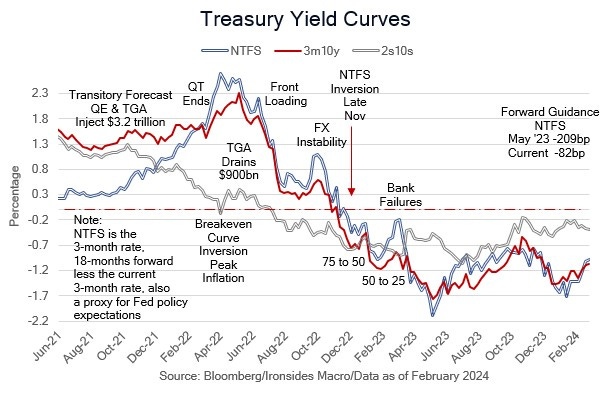Tech Boom Bond Bust
Nvidia NVDA delivered the goods, overwhelming a series of hawkish Fed speeches and FOMC January 30-31 meeting minutes that led to another 10bp in yield across the Treasury curve through Thursday’s close, bringing the move from the late December lows on nominal 10s to over 50bp. Issuance was primarily bills, but the two coupon auctions, 20-year nominals and 30-year TIPS, were poorly received. Next week brings $63 billion of 2s, up from $60 billion last month, $64 billion of 5s, from $61 billion in January and $42 billion of 7s, last month’s $41 billion auction. With net coupon issuance set to increase by greater than $500 billion in coming months, and California’s revenue shortfall potentially portending a second consecutive federal government tax season shortfall, we suspect the Treasury market needs to back up further to absorb growing supply. Meanwhile, with FOMC participants sending an unequivocal message that conditions are not in place for policy easing, it seems likely the brief period of bank interest in the belly of the Treasury curve following the November pause and December pivot party, is over.
Additionally, with the Fed delaying cuts, the associated strength in the dollar implies the December foreign buying of USTs (which we highlighted in a chart last week at the end of our note) won’t persist either. The methodical grind higher in rates and near disinversion of the 2s10s real rate curve is far from a high velocity tightening of financial conditions sufficient to cause a risk-off episode across asset classes. The real curve is bear steepening, which is typically not a favorable backdrop for risky assets. However, given that the move higher in 10-year nominals and TIPS is only a bit above 38.2% Fibonacci retracements of the Treasury reduced coupon issuance and Fed pause 4Q23 rally, the pace will have to accelerate and rates will have to move to at least above 4.5% and 2.25% respectively for negative bond returns to reverberate across other asset classes.
For investors (ourselves included) who are invested in the technology and related sectors Gen AI theme, or in the manufacturing renaissance or energy sector consolidation themes, the market implied delay in easing policy from March to June matters little. However, as evidenced by the widening of the spread of mortgage-backed securities and the associated increase in fixed income implied volatility, the timing matters a great deal to fixed income investors. Consequently, financials, particularly smaller spread sensitive regional banks, as well as the rate sensitive utilities and real estate sectors, are likely to continue to underperform. For additional details, we made additional enhancements to our asset and sector allocation process at the end of the note. In this week’s note, our primary focus is Vice Chair Jefferson’s discussion of easing cycles, we then offer a preview of next week’s data and our updated asset and sector allocation outlook.
(BN) HARKER: WANT TO SEE DISINFLATION ACROSS GOODS AND SERVICES
(BN) HARKER: GREATEST RISK WOULD BE CUTTING RATES TOO SOON
Figure 1: The steepening of the near-term forward spread partially reflects a reassessment of the terminal policy rate, two weeks ago in The Wrong Price we discussed our view that the FOMC’s longer run policy rate forecast was too low. The 3m10y curve needs to disinvert to reopen the bank credit channel.
Edge Rankings
Price Trend
© 2025 Benzinga.com. Benzinga does not provide investment advice. All rights reserved.
Trade confidently with insights and alerts from analyst ratings, free reports and breaking news that affects the stocks you care about.
